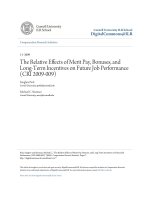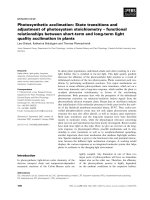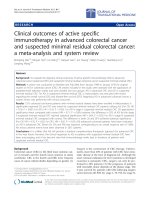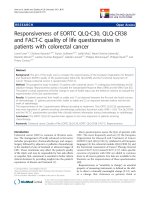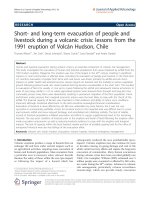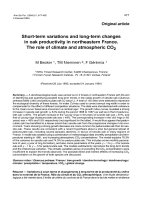The short and long term outcomes of laparoscopic versus open surgery for colorectal cancer a meta analysis
Bạn đang xem bản rút gọn của tài liệu. Xem và tải ngay bản đầy đủ của tài liệu tại đây (1.17 MB, 12 trang )
Int J Colorectal Dis
DOI 10.1007/s00384-013-1827-1
ORIGINAL ARTICLE
The short- and long-term outcomes of laparoscopic versus
open surgery for colorectal cancer: a meta-analysis
Chun-Li Wang & Gang Qu & Hong-Wei Xu
Accepted: 31 December 2013
# Springer-Verlag Berlin Heidelberg 2014
Abstract
Purpose The aim of the study was to compare short- and
long-term outcomes of laparoscopic surgery and conventional
open surgery for colorectal cancer.
Methods Published randomized controlled trial (RCT) reports
of laparoscopic surgery and open surgery for colorectal cancer
were searched, and short- and long-term factors were extracted to perform meta-analysis.
Results A total of 15 RCT reports (6,557 colorectal cancer
patients) were included in this study. Blood loss of laparoscopic surgery was less by 91.06 ml than open surgery
(p= 0.044). Operation time was longer by 49.34 min
(p= 0.000). The length of hospital stay was shorter by
2.64 days (p= 0.003). Incisional length was shorter by
9.23 cm (p=0.000). Fluid intake was shorter by 0.70 day
(p= 0.001). Bowel movement was earlier by 0.95 day
(p=0.000). Incidence of complications, blood transfusion,
and 30 days death were significantly lower in laparoscopic
surgery than in open surgery (p=0.011, 0.000, 0.01). But there
was no significant difference in lymph nodes (p=0.535) and
anastomotic leak (p=0.924). There was also no significant difference in 3 and 5 years overall survival (p=0.298, 0.966), diseasefree survival (p=0.487, 0.356), local recurrence (p=0.270, 0.649),
and no difference in 5 years distant recurrence (p=0.838).
Conclusions Laparoscopic surgery is a mini-injured approach
which can cure colorectal cancer safely and radically, and it is
not different from conventional open surgery in long-term
effectiveness, so laparoscopic surgery can be tried to widely
use in colorectal cancer.
Chun-Li Wang and Gang Qu contributed equally to this work.
C.
Liaoning 116021, People’s Republic of China
e-mail:
C.
Keywords Colorectal cancer . Laparoscopy surgery . Open
surgery . Meta-analysis
Introduction
Colorectal cancer is a common disease which is the fourth
reason resulted to patients’ death [1]. Since the first laparoscopic colorectal surgery was operated successfully in the year
1991 [2], laparoscopic surgery is widely performed in the
colorectal cancer, and the skill is becoming more and more
mature. Its’ security, feasibility, and short-term curative effect
have already been verified [3, 4]. Some randomized controlled
trials (RCTs) have gotten the result that laparoscopic colorectal surgery (LCS) had the better short-term outcomes than
open colorectal surgery (OCS), for example, less blood loss,
better quality life, less pain, the shorter time of return to
normal life and shorter length of hospital stay, and so on [5,
6]. But the post-operation recurrence is the most important
problem which we should consider. And there are few reports
about meta-analysis results of post-operation recurrence between laparoscopic and open surgery, while it is essential firstclass evidence of evidence-based medicine, so several RCTs
comparing LCS and OCS’s short- and long-term outcomes
were selected to have been done meta-analysis. And the
factors of 3 and 5 years following up period below were
concluded to evaluate the long-term results of LCS.
Materials and methods
We looked up many materials about RCTs of colorectal cancer
comparing LCS and OCS which were published from January
1991 to June 2013 and searched the major medical databases
such as Pubmed, Embase, Ovid, ScienceDirect, Springer,
Interscience, and so on. The search terms were used:
Int J Colorectal Dis
“laparoscopy surgery,” “colorectal cancer,” “open surgery,”
“randomized controlled trial,” and so on. Furthermore, we
limited our search to those studies that involved a following
up period of 3 or 5 years to evaluate the long-term outcomes of
LCS. We conducted a meta-analysis for the short and long
term. For the short-term analysis, we collected data of the
operation time, blood loss, number of patients requiring blood
transfusion, number of harvested lymph nodes, time of fluid
intake, bowel movement, anastomotic leak, length of hospital
stay, length of operation incision, complications, and 30 days
death. For the long-term analysis, we used data of the rate of
3 years local recurrence, 3 years overall survival rate, 3 years
disease-free survival rate, 5 years overall survival rate, 5 years
disease-free survival rate, 5 years local recurrence rate, and
5 years distant recurrence.
Egger’s test p>0.05 and 95 % CI includes 1; it is thought that
there was no publication bias). Statistical analyses were
performed using the stata12.0 (meta module) software.
Results
At last 15 papers of RCTs that compared LCS and OCS for
colorectal cancer [5–20] were selected. The characteristics of
each RCT are presented in Table 1. This meta-analysis included 6,557 patients with colorectal cancer in all, of which 3,509
had performed LCS and 3,048 had OCS. The results of the
short and long term are shown in Figs. 1, 2, 3, 4, 5, 6, 7, 8, 9,
10, 11, 12, 13, 14, 15, 16, 17, and 18, respectively, and the data
are presented in Tables 2, 3, 4, 5, 6, 7, 8, 9, 10, 11, 12, 13, 14,
15, 16, 17, 18 and 19.
Statistical analysis
Short-term outcomes
Weighted mean difference (WMD) and odds ratio (OR) were
used for the variables analysis of continuous and dichotomous, respectively. χ2 test was used to evaluate heterogeneity
among the studies, and I2 was used to quantify the inconsistency (there were two models: fixed effect model and random
effect model. The fixed effect model was used when the
effects were deemed to be homogeneous (p>0.1, I2 <50 %);
otherwise, the random effects model was used). And Z test
was used to compare the overall difference. The confidence
interval (CI) was established at 95 %, and p values of less than
0.05 were considered to indicate statistical significance.
Begg’s test and Egger’s test were performed in order to
evaluate the publication bias (in Begg’s test p>0.05 and in
The blood loss for LCS was significantly less than for OCS,
by an average volume of 91.06 ml (WMD=−91.06; 95 % CI=
−179.66 to −2.46; p=0.044); six of the 15 RCTs included data
of blood loss. Operation time for LCS was significantly longer
than for OCS, by 49.34 min (WMD=49.34; 95 % CI=29.57
to −69.12; p=0.000); five of the 15 RCTs included data of
operation time. The length of hospital stay for LCS was
significantly shorter than for OCS, by 2.64 days (WMD=
−2.64; 95 % CI=−4.41 to −0.87; p=0.003); six of the 15
RCTs included data of the length of hospital stay. The
incisional length for LCS was significantly shorter than
for OCS, by an average of 9.23 cm (WMD = −9.23;
Table 1 Characteristics of the randomized control trials
Studies
Year
Reference (n)
29
56
30, 31
15
Study number
Site
Follow-up (months)
Outcome
LCS
OCS
54
32
108
200
428
268
621
345
Colon and rectum
Colon and rectum
Colon
Rectosigmoid
Colon
Colon and rectum
Colon
Rectum
19 (mean)
33 (mean)
44 (mean)
40 (median)
51 (max)
91.8 (mean)
36 (mean)
1
Short and long term
Short and long term
Short and long term
Long term
Long term
Short and long term
Short and long term
Short term
134
374
222
134
27
71
30
Left-sided colon
Rectum
Colon
Colon
Colon
Rectum
Colon and rectum
40 (max)
36 (mean)
Long term
Short and long term
Short term
Short and long term
Short and long term
Short term
Short term
Milsom
Schwandner
Lacy
Leung
Cost
CLASICC
Color
ColorII
1998
1999
2002, 2008
2004
2004
2005, 2007, 2010, 2012
2005
2013
32, 23, 29, 26
30
22
55
32
111
203
435
526
627
699
Liang
Park
LAPKONII
Braga
Fujii
Jing Gong
Pappas-Gogos
2006
2009
2009
2010
2010
2012
2013
30
29
24
21
36
27
42
135
170
250
134
35
67
30
73 (median)
62 (mean)
21 (median)
Int J Colorectal Dis
Fig. 1 Lymph node results of
forest plot (fixed effect model)
Study
%
ID
WMD (95% CI)
Weight
Schwandner
-0.10 (-2.43, 2.23)
15.02
Lacy
0.00 (-2.03, 2.03)
19.92
Liang
-0.40 (-1.53, 0.73)
63.52
Fujii
-1.10 (-8.38, 6.18)
1.54
Overall (I-squared = 0.0%, p = 0.980)
-0.29 (-1.19, 0.62)
100.00
-8.38
Fig. 2 Blood loss result of forest
plot
0
8.38
Study
%
ID
Weight
WMD (95% CI)
Milsom
0.00 (-176.97, 176.97)
10.90
Lacy
-88.00 (-132.02, -43.98)
18.40
Liang
-186.00 (-192.10, -179.90) 19.26
Braga
-81.00 (-130.98, -31.02)
18.16
Fujii
-129.00 (-251.85, -6.15)
14.06
Jing Gong
-32.20 (-43.99, -20.41)
19.21
Overall
-91.06 (-179.66, -2.46)
100.00
(I-squared = 99.1%, p = 0.000)
NOTE: Weights are from random effects analysis
-252
Fig. 3 Operation time result of
forest plot
0
252
Study
%
ID
WMD (95% CI)
Weight
Milsom
75.00 (57.77, 92.23)
22.66
Schwandner
72.00 (36.07, 107.93)
14.38
Lacy
24.00 (11.13, 36.87)
24.53
Liang
40.40 (31.24, 49.56)
25.85
Fujii
45.00 (4.03, 85.97)
12.58
Overall (I-squared = 83.6%, p = 0.000)
49.34 (29.57, 69.12)
100.00
NOTE: Weights are from random effects analysis
-108
0
108
Int J Colorectal Dis
Fig. 4 Length of hospital stay
result of forest plot
%
Study
ID
WMD (95% CI)
Schwandner
-6.60 (-13.48, 0.28) 5.24
Lacy
-2.70 (-4.50, -0.90) 19.84
Liang
-5.00 (-6.58, -3.42) 20.79
Color
-1.10 (-1.87, -0.33) 23.80
Fujii
-4.70 (-9.48, 0.08) 8.86
Color
-0.20 (-1.62, 1.22) 21.49
Overall (I-squared = 82.1%, p = 0.000)
-2.64 (-4.41, -0.87) 100.00
Weight
NOTE: Weights are from random effects analysis
-13.5
Fig. 5 Incisional length result of
forest plot
0
13.5
Study
%
ID
WMD (95% CI)
Milsom
-17.50 (-18.89, -16.11) 24.86
Liang
-7.40 (-7.99, -6.81)
Braga
-12.20 (-12.66, -11.74) 25.39
LAPKON
0.40 (-1.47, 2.27)
24.41
Overall (I-squared = 99.2%, p = 0.000)
-9.23 (-13.77, -4.68)
100.00
Weight
25.35
NOTE: Weights are from random effects analysis
-18.9
Fig. 6 Bowel movement result
of forest plot (fixed effect model)
0
18.9
%
Study
Weight
ID
WMD (95% CI)
Schwandner
-1.00 (-1.79, -0.21) 8.22
Color
-1.00 (-1.27, -0.73) 69.11
Color
-0.80 (-1.27, -0.33) 22.67
Overall (I-squared = 0.0%, p = 0.767)
-0.95 (-1.18, -0.73) 100.00
-1.79
0
1.79
Int J Colorectal Dis
Study
Fig. 7 Fluid intake result of
forest plot
%
ID
WMD (95% CI)
Schwander
-0.50 (-1.14, 0.14) 20.49
Lacy
-1.20 (-1.83, -0.57) 20.92
color
-0.90 (-1.21, -0.59) 33.09
color
-0.20 (-0.70, 0.30) 25.50
Overall (I-squared = 63.5%, p = 0.042)
-0.70 (-1.11, -0.29) 100.00
Weight
NOTE: Weights are from random effects analysis
-1.83
Study
ID
odds
%
ratio (95% CI)
Weight
Milsom
SChwandner
Lacy
Leung
cost
CLASICC
color
Liang
LAPKON
Braga
JingGong
color
Overall (I-squared = 41.2%, p = 0.067)
0.98 (0.40, 2.43) 1.53
.18
1
1.00 (0.48, 2.07) 1.89
0.37 (0.21, 0.64) 7.10
0.88 (0.60, 1.28) 8.58
1.06 (0.82, 1.39) 16.22
0.67 (0.43, 1.05) 7.65
1.00 (0.79, 1.27) 20.93
0.68 (0.41, 1.15) 5.51
1.03 (0.75, 1.42) 10.75
0.61 (0.37, 1.00) 6.25
0.61 (0.18, 2.05) 1.19
0.82 (0.59, 1.14) 12.40
0.86 (0.77, 0.97) 100.00
5.56
Fig. 8 Complication result of forest plot
95 % CI=−13.77 to −4.68; p=0.000); four of the 15 RCTs
included data of incisional length. The bowel movement
time for LCS was significantly shorter than for OCS, by an
average of 0.95 day (WMD=−0.95; 95 % CI=−1.18 to
−0.73; p=0.000); three of the 15 RCTs included data of
bowel movement. The fluid intake for LCS was significantly
Fig. 9 Blood transfusion result
of forest plot
0
1.83
shorter than for OCS, by 0.70 day (WMD=−0.70; 95 % CI=
−1.11 to −0.29; p=0.001); four of the 15 RCTs included data
of the fluid intake. There were no significant differences in
lymph nodes between the LCS group and the OCS group for
treatment of the colorectal cancer. The rate of perioperative
complications for patients in the LCS group was significantly lower than for those in the OCS group in this analysis of
the pooled data for colorectal cancer treatment (OR=0.86;
95 % CI=0.77–0.97; p=0.011). Twelve of the 15 RCTs
included data of perioperative complications. The number
of blood transfusion in the LCS group was significantly
lower than that in the OCS group in this analysis of the
pooled data for colorectal cancer treatment (OR=0.46; 95 %
CI=0.32–0.65; p=0.000). Three of the 15 RCTs included
data of blood transfusion. There were no significant differences in anastomotic leak between the LCS group and the
OCS group for the treatment of the colorectal cancer.
The rate of 30 days death in the LCS group was significantly lower than in the OCS group in this analysis of the
pooled data for colorectal cancer treatment (OR=0.58; 95 %
CI=0.38–0.88; p=0.01). Seven of the 15 RCTs included data
of 30 days death.
Study
odds
ID
ratio (95% CI) Weight
LAPKON
0.66 (0.42, 1.03) 48.51
Braga
0.55 (0.27, 1.10) 23.48
Fujii
0.02 (0.00, 0.38) 28.01
Overall (I-squared = 72.7%, p = 0.026)
0.46 (0.32, 0.65) 100.00
.0015
1
668
%
Int J Colorectal Dis
Fig. 10 Thirty-day death result
of forest plot
Study
odds
%
ID
ratio (95% CI)
Weight
Milsom
0.98 (0.06, 15.30) 1.85
Schwandner
0.33 (0.01, 7.89)
2.74
Lacy
0.32 (0.03, 3.07)
5.56
cost
0.49 (0.09, 2.67)
7.38
color
0.59 (0.22, 1.63)
18.38
Braga
0.59 (0.34, 1.05)
49.40
color
0.66 (0.23, 1.89)
14.68
Overall (I-squared = 0.0%, p = 0.996)
0.58 (0.38, 0.88)
100.00
.0141
Fig. 11 Anastomotic leak result
of forest plot
71
Study
ID
odds
%
ratio (95% CI)
Weight
Leung
0.25 (0.03, 2.18)
5.54
Park
1.17 (0.51, 2.71)
12.88
LAPKON
1.42 (0.47, 4.28)
7.28
Braga
0.80 (0.22, 2.91)
6.87
Fujii
0.59 (0.31, 1.14)
20.17
Jing Gong
1.06 (0.07, 16.60) 1.33
color
1.15 (0.73, 1.80)
45.93
Overall (I-squared = 0.0%, p = 0.543)
0.99 (0.72, 1.34)
100.00
.0278
Fig. 12 Three-year overall
survival result of forest plot
1
1
36
Study
odds
ID
ratio (95% CI) Weight
Schwandner
1.00 (0.88, 1.13) 5.80
Leung
1.02 (0.93, 1.12) 31.35
CLASICC
1.02 (0.92, 1.14) 45.84
Braga
1.09 (0.93, 1.28) 17.01
Overall (I-squared = 0.0%, p = 0.856)
1.03 (0.97, 1.10) 100.00
.779
1
1.28
%
Int J Colorectal Dis
Fig. 13 Three-year disease-free
survival result of forest plot
Study
odds
%
ID
ratio (95% CI)
Weight
cost
1.29 (1.04, 1.59) 19.18
CLASICC
0.98 (0.89, 1.09) 44.77
Park
0.94 (0.86, 1.03) 36.05
Overall (I-squared = 76.5%, p = 0.014)
1.03 (0.95, 1.10) 100.00
.628
Fig. 14 Three-year local
recurrence result of forest plot
1.59
Study
odds
%
ID
ratio (95% CI)
Weight
Schwandner
3.00 (0.13, 71.00)1.74
Park
2.64 (0.82, 8.53) 10.85
CLASICC
1.10 (0.65, 1.86) 87.41
Overall (I-squared = 3.0%, p = 0.356)
1.30 (0.82, 2.07) 100.00
.0141
Fig. 15 Five-year overall
survival result of forest plot
1
1
71
Study
odds
%
ID
ratio (95% CI)
Weight
Leung
1.04 (0.93, 1.17)
17.77
cost
0.96 (0.90, 1.03)
43.22
CLASICC
1.00 (0.88, 1.13)
24.97
Braga
1.09 (0.93, 1.28)
10.63
Fujii
1.02 (0.89, 1.16)
3.41
Overall (I-squared = 0.0%, p = 0.595)
1.00 (0.95, 1.05)
100.00
.779
1
1.28
Int J Colorectal Dis
Fig. 16 Five-year disease-free
survival result of forest plot
Study
odds
%
ID
ratio (95% CI)
Weight
Leung
0.96 (0.86, 1.07) 33.14
CLASICC
0.94 (0.83, 1.07) 43.58
Braga
1.00 (0.83, 1.20) 17.60
Fujii
1.06 (0.91, 1.24) 5.68
Overall (I-squared = 0.0%, p = 0.649)
0.97 (0.90, 1.04) 100.00
.806
Fig. 17 Five-year local
recurrence result of forest plot
1.24
Study
odds
%
ID
ratio (95% CI)
Weight
Lacy
0.49 (0.20, 1.16)
27.44
Leung
1.55 (0.61, 3.91)
13.64
CLASICC
1.26 (0.80, 2.00)
58.92
Overall (I-squared = 53.1%, p = 0.119)
1.09 (0.76, 1.57)
100.00
.204
1
4.9
differences in the 3- and 5-year disease-free survival rates
between patients who underwent LCS and OCS.
Long-term outcomes
We found no significant differences in the rate of 3 years local
recurrence between the surgery groups when we pooled data
for the treatment of the colorectal cancer. Our analysis of the
5 years of local and distant recurrence between the LCS group
and the OCS group for the treatment of the colorectal cancer
indicated no significant difference. There were also no significant differences between the surgery groups for the overall
survival in the 3 and 5 years. We also found no significant
Fig. 18 Five-year distant
recurrence result of forest plot
1
Heterogeneity
In the short-term period, significant heterogeneity was detected among studies with respect to the following six factors:
blood loss, the length of hospital stay, operation time, time of
fluid intake, the rate of perioperative complications, and the
number of blood transfusion. In the long-term period,
Study
odds
%
ID
ratio (95% CI)
Weight
Lacy
0.76 (0.29, 1.96) 8.43
Leung
1.14 (0.70, 1.85) 24.21
CLASICC
1.02 (0.76, 1.36) 67.36
Overall (I-squared = 0.0%, p = 0.754)
1.03 (0.81, 1.30) 100.00
.292
1
3.42
Int J Colorectal Dis
Table 2 Number of lymph nodes compared LCS and OCS (p=0.535)
among four studies (n)
Table 6 Incisional length compared LCS and OCS (p=0.000) among
four studies (in centimeters)
Study
Study
LCS
OCS
Mean2
SD2
LCS
N1
Mean1
SD1
N2
Schwandner
32
12.9
5.1
32
13
4.4
Milsom
55
4.5
Lacy
Liang
Fujii
111
135
35
11.1
15.6
24.1
7.9
3
13.4
108
134
27
11.1
16
25.2
7.4
6
15.3
Liang
Braga
LAPKONII
135
134
250
10.6
5.2
13.4
Table 3 Blood loss compared LCS and OCS (p=0.044) among six
studies (in milliliters)
N1
OCS
LCS
SD1
N2
Mean2
SD2
Milsom
55
344
222
54
344
626
Lacy
Liang
Braga
Fujii
Jing Gong
111
135
134
35
67
105
54
46
125
86.9
99
12
130
214
37.6
108
134
134
27
71
193
240
127
254
119.1
212
34
265
266
32.7
SD2
1.5
54
22
5
1.6
0.8
12
134
134
222
18.0
17.4
13
3.1
2.6
8.6
OCS
Table 4 Operation time compared LCS and OCS (p=0.000) among five
studies (in minutes)
LCS
OCS
N1
Mean1
SD1
N2
Mean2
SD2
Milsom
Schwandner
Lacy
Liang
55
32
111
135
200
281
142
224.4
40
80
52
44.8
54
32
108
134
125
209
118
184
51
66
45
30.6
Fujii
35
255
77
27
210
85
Table 5 Hospital length of stay compared LCS and OCS (p=0.003)
among six studies (in days)
LCS
OCS
N1
Mean1
SD1
N2
Mean2
SD2
32
111
135
627
699
35
15.3
5.2
9.0
8.2
11.9
11.7
6.1
2.1
1.0
6.6
11.8
8.4
32
108
134
621
345
27
21.9
7.9
14.0
9.3
12.1
16.4
18.9
9.3
2.0
7.3
10.6
10.3
Mean1
SD1
N2
Mean2
SD2
Schwandner
32
4.1
1.7
32
5.1
1.5
Color
ColorII
627
699
3.6
2.9
1.7
3.8
621
345
4.6
3.7
3.0
3.6
Table 8 Fluid intake compared LCS and OCS (p=0.001) during four
studies (in days)
Study
Schwandner
Lacy
Liang
Color
ColorII
Fujii
Mean2
LCS
N1
Mean1
Study
N2
OCS
N1
Study
SD1
Table 7 Bowel movement compared LCS and OCS (p=0.000) among
three studies (in days)
Study
Study
Mean1
Schwandner
Lacy
Color
ColorII
LCS
OCS
N1
Mean1
SD1
N2
Mean2
SD2
32
111
627
699
3.1
2.3
2.9
2.6
1.2
1.8
1.9
4.3
32
108
621
345
3.6
3.5
3.8
2.8
1.4
2.8
3.4
3.6
Table 9 Number of complication compared LCS and OCS (p=0.011)
among 12 studies (n)
Study
Milsom
Schwandner
Lacy
Leung
Cost
CLASICC
Color
Liang
LAPKONII
Braga
Jing Gong
ColorII
LCS
OCS
N1
Morbidity1
N2
Morbidity2
55
32
111
203
435
526
627
135
250
134
67
694
8
10
14
40
92
54
111
20
63
20
4
81
54
32
108
200
428
268
621
134
222
134
61
344
8
10
37
45
85
27
110
29
53
33
6
49
Int J Colorectal Dis
Table 10 Number of blood transfusion compared LCS and OCS
(p= 0.000) among three studies (n)
Table 14 Three-year disease-free survival compared LCS and OCS
(p= 0.487) among five studies (n)
Study
Study
LCS
N1
OCS
Morbidity1
N2
Morbidity2
LCS
OCS
N1
Live1
N2
Live2
LAPKONII
250
29
222
39
Cost
435
118
428
117
Braga
Fujii
134
35
11
0
134
27
20
8
CLASICC
Park
526
170
349
132
268
374
181
309
Table 11 Number of 30-day death compared LCS and OCS (p=0.011)
among seven studies (n)
Study
Milsom
Schwandner
Lacy
Cost
Color
Braga
ColorII
LCS
Table 15 Three-year local recurrence compared LCS and OCS
(p= 0.270) among five studies (n)
OCS
N1
Death1
N2
Death2
55
32
111
435
627
134
694
1
0
1
2
6
16
8
54
32
108
428
621
134
344
1
1
3
4
10
27
6
Study
LCS
N1
OCS
Recurrence1
N2
Recurrence2
Schwandner
32
1
32
0
Park
CLASICC
170
526
6
41
374
268
5
19
Table 12 Number of anastomotic leak compared LCS and OCS
(p= 0.924) among seven studies (n)
Table 16 Five-year overall survival compared LCS and OCS (p=0.966)
among five studies (n)
Study
Study
Leung
Park
LAPKONII
Braga
Fujii
Jing Gong
ColorII
LCS
OCS
N1
Morbidity1
N2
Morbidity2
203
170
250
134
35
67
694
1
8
8
4
10
1
58
200
374
222
134
27
71
344
4
15
5
5
13
1
25
Leung
cost
CLASICC
Braga
Fujii
LCS
OCS
N1
Survival1
N2
Survival2
203
435
526
134
35
154
344
305
96
33
200
428
268
134
27
146
359
156
88
25
Table 13 Three-year overall survival compared LCS and OCS
(p= 0.298) among five studies (n)
Table 17 Five-year disease-free survival compared LCS and OCS
(p= 0.356) among five studies (n)
Study
Study
Schwandner
Leung
CLASICC
Braga
LCS
OCS
N1
Live1
N2
Live2
32
203
526
134
30
167
360
96
32
200
268
134
30
161
179
88
Leung
CLASICC
Braga
Fujii
LCS
OCS
N1
Survival1
N2
Survival2
203
526
134
35
153
291
84
33
200
268
134
27
157
157
84
24
Int J Colorectal Dis
Table 18 Five-year local recurrence compared LCS and OCS (p=0.649)
among five studies (n)
Study
LCS
OCS
N1
Recurrencel1
N2
Recurrence2
Lacy
111
7
108
14
Leung
CLASICC
203
526
11
57
200
268
7
23
significant heterogeneity was detected among studies with
respect to the following factors: 3 years disease-free survival,
3 years local recurrence, 5 years overall survival, 5 years
disease-free survival, and 5 years distant recurrence. Random
effect model was used in the above given factors. Fixed effect
model was used in the rest factors. Begg’s test and Egger’s test
were performed, respectively. And all factors below passed
the tests (p>0.05 and 95 % CI includes 1).
Discussion
The biggest advantage of LCS than OCS lies to its minor
injury. And many studies concluded that LCS had lower
complications, less pain, shorter hospital stay, and less time
to return to normal life than ORS in short-term period [9, 21,
22]. But the recurrence is the focus of debate laparoscopic
approach and conventional open approach for the treatment of
colorectal cancer. Therefore, we examined the results of LCS
and compared to those of OCS in short- and long-term periods
by a meta-analysis of 15 RCTs.
From the data meta-analysis, it is indicated that in shortterm period, LCS has less blood loss, lower length of hospital
stay, lower incisional length, less time bowel movement,
lower rate of perioperative complication, lower number of
blood transfusion, and lower number of 30 days death than
OCS. It fits to the LCS’s consistent advantage. LCS is prior
obviously to OCS in post-operation recovery. The length of
hospital stay and time of bowel movement can be shown. But
the operation time of LCS is longer than OCS because laparoscopic approach is more difficult than conventional open
approach. And with surgeons’ richer and richer experience,
the operation time will decrease. LCS is similar to OCS with
Table 19 Five-year distant recurrence compared LCS and OCS
(p= 0.838) among five studies (n)
Study
Lacy
Leung
CLASICC
LCS
no significant differences in lymph nodes and anastomotic
leak, while the number of lymph nodes is one of the most
important factors of prognosis of colorectal cancer patients.
Long-term effectiveness is the basic criterion to evaluate
the tumor radical operation. Long-term survival and recurrence are acknowledged standard criterion to detect if it is
radical surgery-based disease free. There are no significant
differences between LCS and OCS in 3 and 5 years overall
survival and disease-free survival. There are also no significant differences in 3 and 5 years local and distant recurrence
between two groups. So it can be concluded that there are
similar long-term effectiveness between LCS and OCS.
It is considered that the hospital charges of LCS are higher
than those of OCS [23, 24]. The use of disposable surgical
instruments, the high cost of intraoperative anesthesia, and the
higher technical operation requirements made the charges of
LCS higher than those of OCS. But YS Choi et al. ever
separated charge from cost. Cost encompassed anesthesia,
laboratory, radiology, pharmacy, nursing, medical therapy,
and consumables charges, so total hospital charges should be
evaluated by cost-effectiveness analysis. JS Park et al. also
provided that total hospital charges for laparoscopic surgery
were higher than those of open surgery only during the early
learning period and became similar during the experienced
period. So it is hoped the emergence of reusable materials
which can reduce the costs and the shortening of the learning
period to achieve cost-effective. It is also expected to increase
the intensity of insurance of consumables.
In conclusion, this meta-analysis shows that LCS has the
advantage of less blood loss, lower length of hospital stay,
earlier bowel movement, and lower rate of complications than
OCS in the short-term period. And LCS is similar to OCS with
no significant differences in the long-term results. LCS can
safely cure colorectal cancer; anyway, this article also has
shortcomings, due to the lack of relevant data reported on
the application condition of LCS. We at least put forward a
bold attempt; at the same time, it is also hoped that more
scholars and researchers can come together to explore and
apply laparoscopic surgery routinely to the treatment of colorectal cancer.
Conflict of interest This article was supported by grants from the
Medical Science Foundation of health ministry in Dalian city (no.201380).
OCS
N1
Recurrence1
N2
Recurrence2
111
203
526
7
30
110
108
200
268
9
26
55
References
1. Ohtani H, Tamamori Y, Azuma T et al (2011) A meta-analysis of the
short-and long-term results of randomized controlled trials that compared laparoscopy-assisted and conventional open surgery for rectal
cancer. J Gastrointest Surg 15(8):1375–1385
Int J Colorectal Dis
2. Jacobs M, Verdeja J, Goldstein H (1991) Minimally invasive colon
resection (laparoscopic colectomy). Surg Laparosc Endosc Per Tech
1(3):144–150
3. Guillou PJ, Quirke P, Thorpe H et al (2005) Short-term
endpoints of conventional versus laparoscopic-assisted surgery
in patients with colorectal cancer (MRC CLASICC trial):
multicentre, randomised controlled trial. Lancet 365(9472):
1718–1726
4. Lord SA, Larach SW, Ferrara A et al (1996) Laparoscopic resections
for colorectal carcinoma. Dis Colon Rectum 39(2):148–154
5. Lacy AM, García-Valdecasas JC, Delgado S et al (2002)
Laparoscopy-assisted colectomy versus open colectomy for treatment of non-metastatic colon cancer: a randomised trial. Lancet
359(9325):2224–2229
6. Milsom JW, Böhm B, Hammerhofer KA et al (1998) A prospective,
randomized trial comparing laparoscopic versus conventional techniques in colorectal cancer surgery: a preliminary report. J Am Coll
Surg 187(1):46–54
7. Braga M, Frasson M, Zuliani W et al (2010) Randomized clinical trial
of laparoscopic versus open left colonic resection. Br J Surg 97(8):
1180–1186
8. Fujii S, Ota M, Ichikawa Y et al (2010) Comparison of short, longterm surgical outcomes and mid-term health-related quality of life
after laparoscopic and open resection for colorectal cancer: a casematched control study. Int J Colorectal Dis 25(11):1311–1323
9. Gong J, Shi D-B, Li X-X et al (2012) Short-term outcomes of
laparoscopic total mesorectal excision compared to open surgery.
World J Gastroenterol WJG 18(48):7308
10. Green B, Marshall H, Collinson F et al (2013) Long-term follow-up
of the Medical Research Council CLASICC trial of conventional
versus laparoscopically assisted resection in colorectal cancer.
Br J Surg 100(1):75–82
11. Jayne D, Thorpe H, Copeland J et al (2010) Five-year follow-up of
the Medical Research Council CLASICC trial of laparoscopically
assisted versus open surgery for colorectal cancer. Br J Surg 97(11):
1638–1645
12. Jayne DG, Guillou PJ, Thorpe H et al (2007) Randomized trial of
laparoscopic-assisted resection of colorectal carcinoma: 3-year results of the UK MRC CLASICC Trial Group. J Clin Oncol 25(21):
3061–3068
13. Jeng Y-M (2007) Oncologic results of laparoscopic versus conventional open surgery for stage II or III left-sided colon cancers: a
randomized controlled trial. Ann Surg Oncol 14(1):109–117
14. Lacy AM, Delgado S, Castells A et al (2008) The long-term results of
a randomized clinical trial of laparoscopy-assisted versus open surgery for colon cancer. Ann Surg 248(1):1–7
15. Nelson HSD, Wieand HS et al (2004) Laparoscopically assisted
colectomy is as safe and effective as open colectomy in people with
colon cancer Abstracted from: Nelson H, Sargent D, Wieand HS,
et al.; for the Clinical Outcomes of Surgical Therapy Study Group. A
comparison of laparoscopically assisted and open colectomy for
colon cancer. N Engl J Med 350:2050–2059, Cancer Treat Rev
30(8):707–709
16. Neudecker J, Klein F, Bittner R et al (2009) Short-term outcomes
from a prospective randomized trial comparing laparoscopic and
open surgery for colorectal cancer. Br J Surg 96(12):1458–1467
17. Pappas-Gogos G, Tellis C, Lasithiotakis K et al (2013) Oxidative
stress markers in laparoscopic versus open colectomy for cancer: a
double-blind randomized study. Surg Endosc 27(7):2357–2365
18. Park IJ, Choi G-S, Lim K-H et al (2009) Laparoscopic resection of
extraperitoneal rectal cancer: a comparative analysis with open resection. Surg Endosc 23(8):1818–1824
19. Schwandner O, Schiedeck T, Killaitis C et al (1999) A case–controlstudy comparing laparoscopic versus open surgery for rectosigmoidal
and rectal cancer. Int J Colorectal Dis 14(3):158–163
20. van der Pas MH, Haglind E, Cuesta MA et al (2013) Laparoscopic
versus open surgery for rectal cancer (COLOR II): short-term outcomes of a randomised, phase 3 trial. Lancet Oncol 14:210–218
21. Chan AC, Poon JT, Fan JK et al (2008) Impact of conversion on the
long-term outcome in laparoscopic resection of colorectal cancer.
Surg Endosc 22(12):2625–2630
22. Park JS, Choi G-S, Jun SH et al (2013) Long-term outcomes after
laparoscopic surgery versus open surgery for rectal cancer: a propensity score analysis. Ann Surg Oncol 20:2633–2640
23. Choi YS, Lee S-I, Lee T-G et al (2007) Economic outcomes of
laparoscopic versus open surgery for colorectal cancer in Korea.
Surg Today 37(2):127–132
24. Park J-S, Kang S-B, Kim S-W et al (2007) Economics and the
laparoscopic surgery learning curve: comparison with open surgery
for rectosigmoid cancer. World J Surg 31(9):1827–1834
